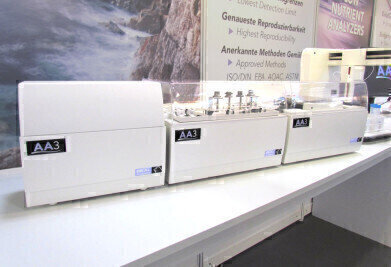Water/Wastewater
Long-Term Seawater Analysis has Global Significance
Jan 31 2013
Since 1988, scientists from the University of Hawaii have been conducting almost monthly deep-sea research expeditions to collect water samples for subsequent laboratory analysis. Originally designed to characterise subtle long-term changes in environments that were believed to be stable, the work has revealed some surprising conclusions. For example, it has become evident that even in these quasi-stable ocean systems, gradual environmental change can often result in abrupt shifts from the equilibrium state.
An important part of the work involves the collection of nutrient samples to a depth of 4800 metres. These are then frozen for subsequent analysis in the University's laboratory with a high precision SEAL Analytical (Germany) AutoAnalyzer 3 (AA3) Segmented Flow Analyser.
The sampling site is known as 'Station ALOHA', a Long-Term Oligotrophic Habitat Assessment located 100 km north of Oahu, Hawaii as part of the Hawaii Ocean Time-series program (HOT), which is based out of the School of Ocean and Earth Science and Technology (SOEST) and receives funding from the U.S. National Science Foundation.
The HOT program provides an unprecedented historical context for refining our understanding of the often subtle linkages between ocean-climate and marine biogeochemistry. Without these time-series observations, many of the processes controlling biogeochemical cycles in the deep ocean would remain obscured by the inherent complexity of the oceanic habitat.
Systematic, long-term time-series studies of selected aquatic and terrestrial habitats have yielded significant contributions to earth and ocean sciences through the characterisation of climate trends. Important examples include the recognition of acid rain, the documentation of increasing carbon dioxide (CO2) in the earth's atmosphere and the description of large scale ocean-atmosphere climate interactions in the equatorial Pacific Ocean.
Long time-series observations of climate-relevant variables in the ocean are extremely important because repeated oceanographic measurements are required to gain an understanding of natural processes or phenomena that exhibit slow or irregular change, as well as rapid event-driven variations that are impossible to document reliably from a single field expedition. Time-series studies are also ideally suited for the documentation of complex natural phenomena that are under the combined influence of physical, chemical and biological controls.
The oceans are known to play a central role in regulating the global concentration of CO2 in the atmosphere and it is generally believed that the world ocean has removed a significant portion of anthropogenic atmospheric CO2. It is clear therefore that a better understanding of the interactions between the atmosphere and the ocean is essential if we are to make informed decisions about how to protect the environment.
Measurements of water column chemistry, currents, optical properties, primary production, plankton community structure, and rates of particle export are made on each cruise and both inorganic and organic nutrient samples are analyzed to provide a clear picture of the water column.
The SEAL Analytical AA3 analyser is capable of analysing up to 300 tests per hour. Susan Curless has acted as the lead nutrient analyst for the HOT program from January 2005 and has employed the AA3 for nutrient analysis since that time. Susan is also one of the chief scientists of the HOT program, so when she is not out at sea organising, planning, and leading research cruises, she is in the laboratory analysing nutrient samples.
Susan also utilises the AA3 for nutrient samples collected on CMORE (Centre for Microbial Oceanography: Research and Education) cruises.
Speaking on behalf of SEAL Analytical, Stuart Smith says: "A great deal of time, effort and money goes in to the creation of seawater samples in the HOT program. Furthermore, the data that these samples provide is of global significance, so it is hardly surprising that the program chose a high performance instrument with a reputation as the world's most reliable segmented flow analyser.
"Leading seawater laboratory and research institutes use the SEAL AutoAnalyzer 3 and QuAAtro instruments because as well as being reliable laboratory instruments, these analysers are designed to provide high resolution analysis despite tough conditions onboard an oceangoing research vessel, and are in routine ship-board use from the Arctic Ocean to the Weddel Sea."
Digital Edition
AET 28.4 Oct/Nov 2024
November 2024
Gas Detection - Go from lagging to leading: why investment in gas detection makes sense Air Monitoring - Swirl and vortex meters will aid green hydrogen production - Beyond the Stack: Emi...
View all digital editions
Events
Dec 02 2024 London, UK
Dec 03 2024 Dusseldorf, Germany
Dec 11 2024 Shanghai, China
Jan 12 2025 Abu Dhabi, UAE
Jan 14 2025 Abu Dhabi, UAE








.jpg)










